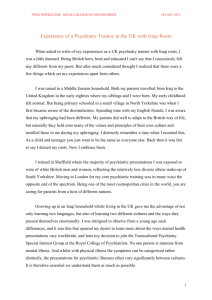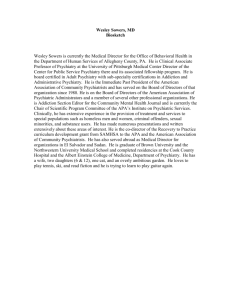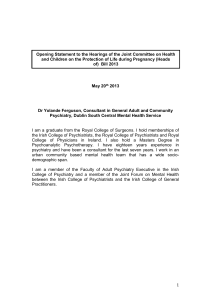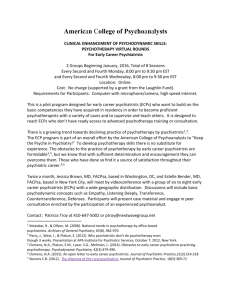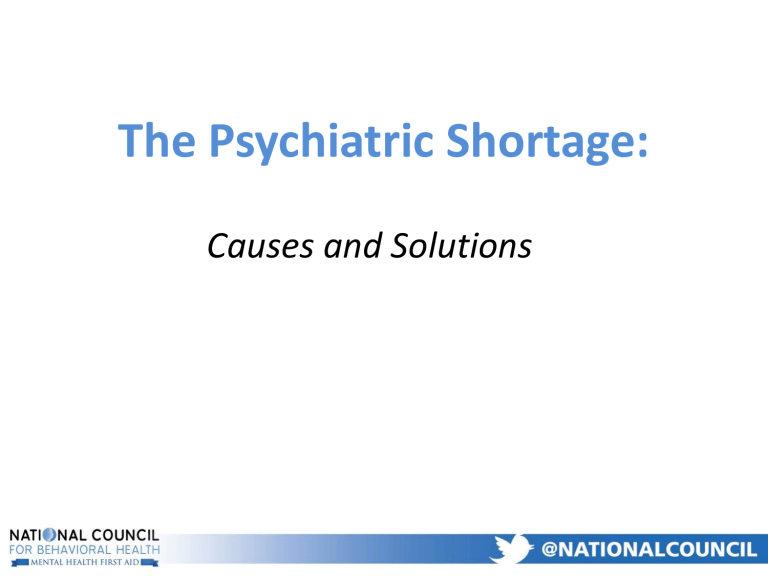
The Psychiatric Shortage: Causes and Solutions My Background • Medical Director for National Council for Behavioral Health • Practicing Psychiatrist in a Community Health Center • Distinguished Professor, Missouri Institute of Mental Health, University of Missouri St. Louis • Previously – Medicaid Director for Missouri – Medical Director Missouri Department of Mental Health Source: Heisler and Bagalman, Congressional Research Service, April 2015 CURRENT SHORTAGE • Best data: Study by University of North Carolina commissioned by Health Resources and Services Administration (HRSA) • Demonstrated shortages for all MH professionals, especially “prescribers” • 77% of U.S. Counties have “a severe shortage of prescribers, with over half their need unmet” • 96% of US counties have “some unmet need” Konrad et al, Psych Services, 60: 1307-14, 2009 Total # Active Psychiatrists in US adult psych child psych 8 237 Total = 45,533 37 296 Source: AAMC Center for Workforce Studies, Physician Specialty Databook, 2014 Total Number of Doctors in US – Steady Increase Number of All U.S. Physicians 1970-2010 1 000 000 900 000 800 000 700 000 600 000 500 000 400 000 300 000 200 000 100 000 0 1970 1980 1990 2000 2010 Total Number of Psychiatrists (including FMG’s) - Slight Increase Number of Psychiatrists and Child Psychiatrists in the US 1970 - 2010 50 000 45 000 40 000 35 000 30 000 25 000 20 000 15 000 10 000 5 000 0 1970 1980 Psychiatry (General) 1990 2000 Child Psychiatry 2010 Number of Psychiatry Residents In US Programs Has Been Flat Over Past 30 Years Number of Psychiatry Residents and Fellows in U.S. Programs, 19702010 7000 6000 5000 4000 3000 2000 1000 0 1970 1975 1980 1985 1990 1995 2000 2005 2010 Aging Out! % of MD’s by Specialty > age 55 • Off all sub-specialties (35), Psychiatry is second oldest (Second only to Preventive Medicine) 54,5 % > Age 55 32,3 33,6 Internal Medicine Pediatrics 36,7 38,5 • 55% of current psychiatrist are > age 55 Family Practice Ob/Gyn Psychiatry Current supply and need of psychiatrists • Estimated need of 25.9 psychiatrists/100,000 population – With current population of 300,000,000, this is 78,000. • Current supply is ~ 48,000 (~ 16/100,000) • Current gap = at least 30,000 • Much greater supply vs. need gap for child and adolescent psychiatry (~ 7,500 total) Sources: Konrad et al, Psych Services, 60: 1307-14, 2009 Drivers of Increased Demand for Behavioral Health Care • ACA Insurance reforms and Medicaid expansion substantially increases behavioral health coverage for adults • ACA requires newly covered populations meet the parity requirements of Wellstone Domenici Parity Act • Multiple parts of ACA require or incentivize integration of Behavioral Health and general medical care • Stigma continues to drop releasing pent up demand • In responding to recent press coverage of mass shootings increasing mental health services is more popular than gun control Consequences • For referring primary care physicians – 2 out of 3 reported difficulty accessing psychiatric services • For Emergency Departments – 42% increase in individuals using EDs to obtain psychiatric services over the last 3 years. – Patients stuck waiting for evaluations and referrals – Frustrated ER staff, impacts care of other patients • For inpatient psychiatric services – Closure of psychiatric inpatient units – Unable to recruit and retain psychiatrists Consequences • Inadequate diagnosis, prescribing and overuse of antipsychotics among vulnerable populations • Lack of timely access to collateral clinical information and less time to talk with patient’s family or other caregivers • Prescriptions refilled without monitoring for side-effects • Rationing services to most severe illnesses, limiting access for patients milder conditions Extended Outpatient Wait Times • Common in all settings • High risk in publicly-funded community behavioral health centers (Medicaid-covered) – Centers have high percentage of chronic mental health disorders • Can lead to medication non-adherence with more ED visits and hospitalizations Consumer Experience • Low patient satisfaction in community mental health centers due to: – Quality of patient-clinician interaction – Time limit (often 15 minutes) “Compressed time with patients may lead to cold environments and an over-focus on deficits or weaknesses that may disempower or frustrate individuals” – Depression and Bipolar Support Alliance (DBSA) Contributing Causes Workforce Shortage Contributing Factors • • • • Psychiatrists burnout Rates and methods of reimbursement Documentation requirements Regulatory restrictions Populations Served by Existing Workforce Cash-only private practice is common. Outpatient Reimbursement • More than 75% of the National Council’s state association members lost $$ on psychiatry – 3 year losses increased from $481,000 in 2013 to more than $550,000 • Must earn surplus of 15% or more to balance budget Inpatient Reimbursement • Rates not sufficient to underwrite their cost of psychiatrists in general hospitals • Reimbursement rates lower than cost of care lead to psychiatric inpatient unit closures • Reluctance to admit potentially violent clients due to risk of property damage, funding security staff • Salaries for psychiatrists are lowest among specialties Consequences • Inadequate workforce has limited ability to deliver safe and effective care • Low level of patient satisfaction • Limited opportunities for innovation • Less supervision and collaboration • Limited opportunities to practice up to level of licensure • Residency training does not provide adequate population health skills • Psychiatry is a “loss leader,” despite emerging acceptance of its value Conclusions • The shortage of psychiatrists will increase • Traditional model of psychiatric care delivery is unsustainable • Psychiatrists are not sufficiently groomed or practicing up to level of licensure • Increasing number of psychiatrists will not be sufficient enough to improve access and quality of care Solutions and Recommendations Overview of Recommendations • Expand the psychiatric workforce • Increase efficiency of delivery of services – Reforming and revising constraining regulations • Implement innovative models of care to impact total cost of care for high-cost/high-risk populations • Improve training for psychiatric residents • Adopt effective payment structures Update Psychiatry Residency Training • Design new skills, including: – – – – Team leadership Health care data analysis Population health Impact of chronic medical conditions on mental illness • Increase availability of training beyond inpatient/outpatient mental health programs • Practice in settings that include expanded role for families supporting care Expand Workforce of Other Providers • Develop Physician Assistants psychiatric subspecialty • Expand Clinical Pharmacists board certified in Psychiatry • Expand APRNs – Valuable for patients with co-occurring medical conditions • Currently 13,815 • Projected to reach 17,900 by 2025 Recommendations for Treatment Organizations • Attract and retain psychiatrists in public settings: – – – – – Provide Adequate nursing and administrative supports Do not limit psychiatrists solely to diagnosis and medication visits Reduce documentation requirements Have a Medical Director Attention to provider burnout, retention and appreciation Adequate Staff Support • Support staff includes nurses, medical assistants, nonlicensed personnel with specialty training • Duties: – – – – – – Handling phone calls Collecting screening info and vital signs Assuring all required forms are available Arranging referrals, return visits Tracking lab/pharmacy information Making photocopies Integrated Care • • • • • • • Makes functional integration easier Decreases discrimination Increases access to primary care consultations Creates common medical record Increases patient follow-through with referrals Preferred by most patients Increases primary care practitioners’ knowledge of psychiatric treatment and vice versa Collaborative Care Model • Good evidence for the success of the collaborative care model (CoCM) resulted in new CPT code • Stepped care approach includes case manager to measure outcomes • Allows each psychiatrist to impact 5 times as many patients Recommendations for Payers • Incentivize open access or walk-in clinics • Pay higher amounts for first appointments to incentivize providers to target harder-to-reach populations • Include telepsychiatry as covered service • Improve access to psychiatric care in EDs • Cover payment for CoCM at no less than Medicare rate • Reimburse for psychiatric services using evolving technologies for increased access Recommendations for Payers • Ensure that administrative and documentation policies are not overly burdensome • Design payments with population-based health in mind with actual cost of direct psychiatric services in bundled payment calculation • Ensure compliance with MHPAEA and new Medicaid rule 35 Access Parity via Rate Parity • Rates paid by Insurers yield lower access to available psychiatrists than other physician types – 45% of Psychiatrists don’t take insurance – A larger portion of psychiatrists on panel don’t take new patients – Rate inequity is a Non-Quantitative Parity restriction • Recommend – CMS and State and Federal Insurance regulators should benchmark psychiatry rates and access using secret shopper surveys Questions ? • The paper can be accessed here: https://www.thenationalcouncil.org/wpcontent/uploads/2017/03/PsychiatricShortage_National-Council-.pdf • JoeP@thenationalCouncil.org Medicaid Graduate Medical Education HHS Healthcare Workforce Training • 72 Programs Total • 75% of Funding goes to Graduate Medical Education (GME) • Major Programs – – – – – – Medicare GME $11.3 Billion ($137,000/FTE) Medicaid GME $4.26 Billion VA $1.52 Billion ($146,000/FTE) DOD $ 16.5 Million HRSA Teaching Health Center $60 M ($95,000/FTE) HRSA Children’s Hospital GME $295 Million 8/16/2023 Medicare GME • • • • Only pays for Physician training Only pays teaching hospitals Does not influence specialty or training content Based on fixed formulas for 2 components – Direct – Resident & Faculty costs – Indirect – Increased cost of care at teaching hospitals • Capped in 1997 except for new Hospitals 8/16/2023 Medicaid GME • Not Mandatory – 42 States and DC participate • No Federal Guidance – broad flexibility • Sole Limitation is the Medicare UPL – Medicaid cannot pay more than the maximum allowable under Medicare • Not Limited to Physician training • Not Limited solely to teaching Hospital payments • States can structure it to pursue specific policy goals 8/16/2023 States not using Medicaid GME • • • • • • Alaska California Massachusetts New Hampshire North Carolina - Terminated January 1, 2016 Rhode Island - Proposal denied by CMS for exceeding Medicaid inpatient UPL • Wyoming 8/16/2023 Medicaid GME Payment Methods • FFS or MCO Route – FFS 40 states and DC – MCO 26 states and DC 39% total funds 61% total funds • Types – Part of the case rate/per diem – Separate Direct Payment – Supplemental or special payment • Medicare or Alternative Methodology – Similar to Medicare method - 14 states – Alternative methods – 29 States – Intergovernmental Transfer – MT, TX 8/16/2023 Recipients of Medicaid GME Funding • Payments to: – – – – Predominantly teaching hospitals Non-Hospital Teaching sites – KA, MN, WV Medical schools –MN, OK, TN Individual Teaching Physicians – FL, SC • Payments for Non-Physicians in 14 States: – Nursing (11 States) – Others (11 States) – Dentists, Chiropractors, EMS, PAs, Radiology tech, lab tech, clinical pastoral 8/16/2023 Opportunity • Funding not used for Medicaid match at Behavioral health provider organizations could be used as for next Medicaid GME payments • Funding not currently used for Medicaid match at universities could be repurposed for Medicaid GME. Is your state mental health authority currently directly funding university mental health training programs with unmatched dollars? • Local tax revenues could be used to fund Medicaid GME via intergovernmental transfer • Payments can be structured with requirements for specific provider types and locations
